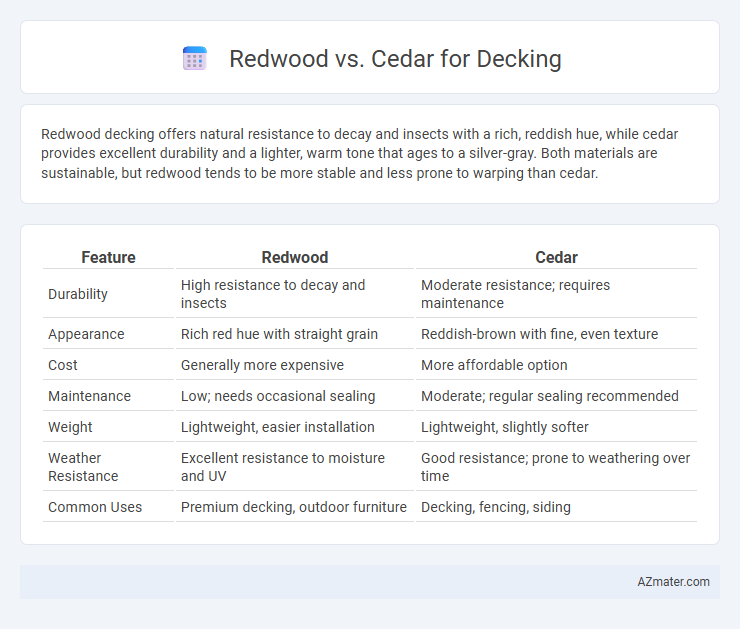Redwood decking offers natural resistance to decay and insects with a rich, reddish hue, while cedar provides excellent durability and a lighter, warm tone that ages to a silver-gray. Both materials are sustainable, but redwood tends to be more stable and less prone to warping than cedar.
Table of Comparison
| Feature | Redwood | Cedar |
|---|---|---|
| Durability | High resistance to decay and insects | Moderate resistance; requires maintenance |
| Appearance | Rich red hue with straight grain | Reddish-brown with fine, even texture |
| Cost | Generally more expensive | More affordable option |
| Maintenance | Low; needs occasional sealing | Moderate; regular sealing recommended |
| Weight | Lightweight, easier installation | Lightweight, slightly softer |
| Weather Resistance | Excellent resistance to moisture and UV | Good resistance; prone to weathering over time |
| Common Uses | Premium decking, outdoor furniture | Decking, fencing, siding |
Introduction to Redwood and Cedar Decking
Redwood decking offers natural resistance to decay and insects, making it a durable choice for outdoor spaces. Cedar decking is renowned for its rich color, fine grain, and natural preservatives that protect against rot and warping. Both woods provide aesthetic appeal and longevity, with redwood typically featuring a warm reddish hue while cedar ranges from light amber to deep red tones.
Key Differences Between Redwood and Cedar
Redwood features a rich reddish hue with natural resistance to decay and insect damage, making it ideal for long-lasting decking. Cedar offers a lighter color palette with excellent stability and a pleasant aroma, known for its resistance to warping and cracking under varying weather conditions. Both woods provide durability, but redwood generally has a higher tensile strength, while cedar's natural oils offer superior resistance to moisture and rot.
Durability and Lifespan Comparison
Redwood and cedar both offer excellent durability for decking, but redwood typically has a longer lifespan due to its dense grain and natural resistance to decay and insects. Cedar, while slightly softer and less dense, features natural oils that provide good resistance to rot and insect damage, lasting around 15-30 years with proper maintenance. Redwood decks can often endure 25-30 years or more, making them a preferred choice for longevity in outdoor environments.
Resistance to Rot and Insects
Redwood offers superior natural resistance to rot and insects due to its high tannin content, making it a durable choice for decking in damp or termite-prone areas. Cedar also provides good resistance to decay and insect damage but typically requires more frequent maintenance and sealing to maintain its protective qualities. Both woods benefit from proper installation and periodic treatment to extend their lifespan against environmental challenges.
Maintenance Requirements
Redwood decking requires regular sealing and staining every 2-3 years to protect against weathering and maintain its rich color, while cedar demands more frequent treatment, typically annually, due to its softer wood and susceptibility to moisture damage. Both woods benefit from routine cleaning to prevent mold and mildew buildup, but cedar's higher resin content can make it trickier to maintain a consistent finish. Proper upkeep of either material extends durability and preserves aesthetic appeal, with redwood generally favored for slightly easier long-term maintenance.
Appearance and Color Options
Redwood decking showcases a rich, deep red hue with natural variations that enhance its luxurious appearance, while cedar offers a lighter palette ranging from pale amber to reddish-brown tones, providing versatile design options. Both woods develop a beautiful, weathered silver-gray patina over time if left untreated, but cedar's softer grain gives it a more uniform look compared to redwood's pronounced growth rings. Choosing between redwood and cedar involves considering the desired aesthetic, as redwood's warm, bold color stands out, whereas cedar's subtle hues blend seamlessly with various architectural styles.
Environmental Impact and Sustainability
Redwood decking offers a renewable and biodegradable option, often sourced from sustainably managed forests certified by organizations such as the Forest Stewardship Council (FSC). Cedar also boasts strong sustainability credentials due to its natural resistance to decay, which reduces the need for chemical treatments and extends the lifespan of decking, decreasing environmental waste. Both woods have low embodied energy compared to composite materials, but redwood's faster growth cycle generally results in a smaller carbon footprint over time.
Cost Comparison: Redwood vs Cedar
Redwood decking typically costs between $8 and $15 per square foot, making it slightly more expensive than cedar, which ranges from $6 to $12 per square foot. This price difference is influenced by redwood's higher durability and natural resistance to decay and insects, justifying its premium cost. Cedar offers a more budget-friendly option, though it may require more maintenance to achieve similar longevity as redwood in outdoor decking applications.
Workability and Installation
Redwood offers superior workability due to its soft, straight grain and uniform texture, making it easier to cut, shape, and fasten during decking installation. Cedar, while slightly harder, is still relatively easy to work with but may require pre-drilling to prevent splitting, especially around fasteners. Both woods allow for straightforward installation, but redwood's natural stability and reduced warping can result in faster, more efficient decking assembly.
Choosing the Right Wood for Your Deck
Redwood offers exceptional natural resistance to decay and insects, making it ideal for long-lasting decking with a rich reddish hue that ages gracefully. Cedar provides a lighter color palette and excellent dimensional stability, reducing warping and splitting, while naturally repelling moisture and pests. Selecting between redwood and cedar depends on your desired aesthetic, durability requirements, and climate conditions affecting wood performance.

Infographic: Redwood vs Cedar for Decking
 azmater.com
azmater.com